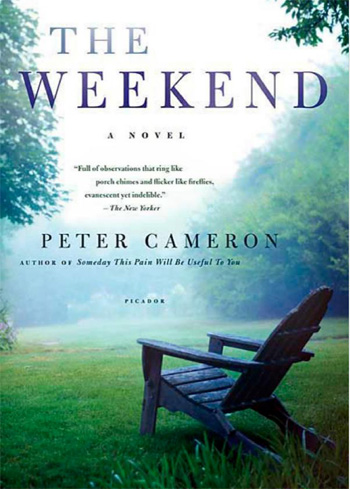 The Weekend
The Weekend
by Peter Cameron
Published by Farrar Straus & Giroux
Published May 1994
Fiction
241 pgs. • Find on Amazon.com
Reviewed by Stephen O. Murray
September 21, 2002.
Having enthusiastically reviewed Peter Cameron’s (1959–) other [then four] novels over the course of the summer [of 2002], my admiration for his writing is abundantly on record. I don’t like The Weekend, his second novel quite as much as the others (Leap Year, Andorra, The City of Your Final Destination), perhaps because the essence of it is in a story, “The Departing,” that I’d read [1]The story was originally published in the Yale Review and then in an O. Henry Award winner collection and Cameron’s short story collection, The Half You Don’t Know.
Most of the book—including most of its flashbacks—takes place on an upstate New York farmhouse that is owned by the main guest’s dead lover’s half-brother, John, and John’s wife, Marian, who is a close friend of the widower-guest. Lyle loves the place, where he and Toby often went, but has not been back since Toby’s death from AIDS complication until he accepts an invitation for the weekend on which the anniversary of Toby’s death will fall.
Marian expects to commiserate with Lyle and is thrown off balance by his asking to bring along another man, Robert, a half-Indian fledgling painter who works as a waiter in a lower-Manhattan Indian restaurant. John is more than comfortable with what Marian feels is an aggressive betrayal—more of her intimacy with Lyle than a failure of mourning widow(er)hood. What pleases Lyle—discovering that he might change and have another significant relationship—threatens Marian.
When Toby was dying in the farmhouse, Marian had been focused on getting pregnant (which does not square with having a one-year-old: the baby should not be more than four months old). Now she is very concerned that the child is defective, not yet speaking or walking. My description of her is harsher than I felt her character to be while reading the novel, but she is the least sympathetic of the main figures.
The most sympathetic characters are the interlopers: Robert and Laura, the latter a rich woman who is renting a neighboring house but usually lives in Italy. They get most of the best dialogue lines, though Lyle is the professional wordsmith, an art critic by trade who believes painting is dead but is sponsoring Robert by providing him studio space in what had been the study where Toby wrote travel articles.
Cameron has plenty of good lines too. For instance, in regard to Laura’s daughter Nina, a star of insipid movies, “had always been precocious and independent; she had never seemed especially interested in having a mother.” (It’s the “having” that makes me laugh.) Or this rendering of Robert watching Lyle with his old friends:
It was strange to see someone you have only known alone begin interacting with other people, for that somebody known to you disappears and is replaced by a different, more complex person. You watch him revolve in this new company, revealing new facets, and there is nothing you can do but hope you like these other sides as much as you like the side that seemed whole when it faced only you.
Feelings get hurt, Robert’s in particular, and a grape scissors becomes a pretext for unleashing frustrations into aggressions and an explosion in the woods on a dark night. Although there is less plot than in any of Cameron’s other three novels, some things do happen, and Nina and Robert face disappointment—together and separately. John, the least highly-strung of the characters, has a wall on which to continue work and the mother of his child to try to comfort. What Lyle and Marian have (together and individually) at the end is an open question. Everyone except the infant Roland (even John) has had an emotionally exhausting weekend.
I confess that I am a bit puzzled at the passage of a young South Asian to upstate New York lacking any racial/cultural frisson—Robert’s youthful romanticism matters and he has a room-mate who expresses gay urbanite contempt for heterosexual suburbia, but no one evidences either attraction or repulsion to an exoticness that I’d expect someone or another to project onto him.

In the E.M. Forster tradition, Cameron very subtlely shows people blundering through life causing pain to others and disappointment to themselves. Cameron is a splendid prose stylist who also draws interesting characters and situations. In his two more recent novels it seems to me that he has accomplished something of Toby’s ambition, writing about imaginary 19th-century countries supplied with 20th century plumbing and electricity (though he conscripted the names of Andorra and Uruguay for them).
As I have said before, reading Cameron’s collected works has been a major pleasure of my summer. I look forward to the appearance of more books from him and heartily recommend this and his other three novels to those who share my taste for the stylish prose, artful construction, and deep compassion in the novels of E. M. Forster, Part Barker, Michael Chabon, Michael Cunningham, and Penelope Fitzgerald.
first published on epinions, 21 September 2002
©2002, 2016, Stephen O. Murray

